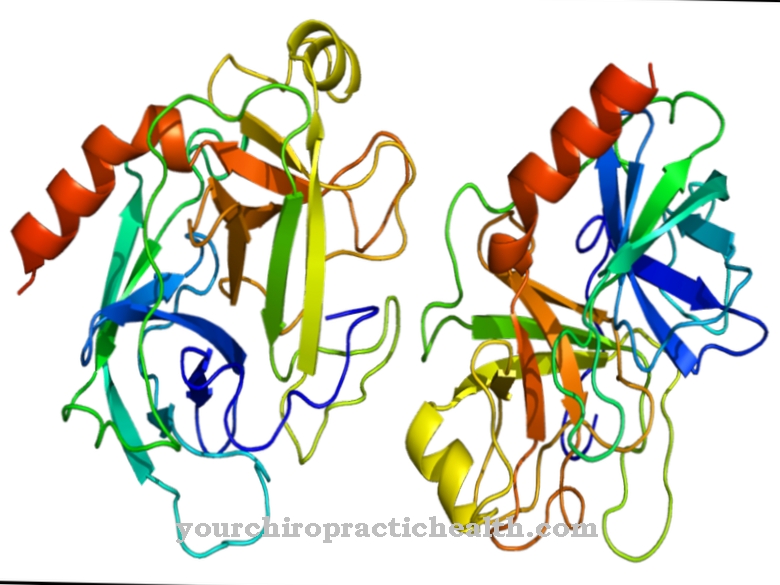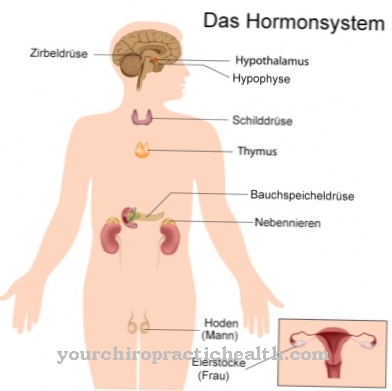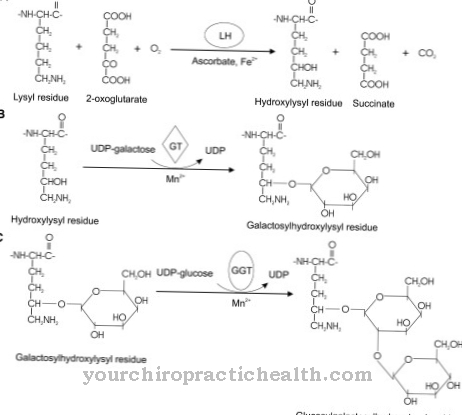As Plasma proteins are called the proteins of the blood plasma. They differ from serum proteins mainly in the coagulation factors. The plasma proteins take on numerous tasks in the organism and can be affected by deficiency symptoms in the context of various diseases.
What are plasma proteins?
The medical professional understands the plasma proteins to be the proteins of the blood plasma, also known as Blood protein are designated. Plasma differs from blood serum in terms of its coagulation factors, which also belong to the plasma proteins. In total, there are around one hundred different proteins and glycoproteins in the blood plasma. The proteins make up about six to eight grams for every 100 milliliters of blood plasma. The term serum protein must be distinguished from plasma proteins.
Serum proteins are all blood proteins minus the coagulation factor fibrinogen. The plasma proteins can be split into albumins and globulins via electrophoresis. This means that the proteins in the blood plasma, as charged colloidal parts or molecules, divide into albumins and globulins as they migrate across an electric field. These two groups are present in the plasma in an approximate ratio of 40 to 60 percent.
Anatomy & structure
Globulins are either α1-, α2-, γ- or β-globulins. The electrophoretic mobility of these four subgroups is their main distinguishing feature. In addition to around four percent α1 globulins, the plasma also contains around eight percent α2 globulins and twelve percent β globulins. The γ-globulins make up the largest proportion of the blood plasma at 16 percent. The biosynthesis of plasma proteins takes place mainly in the liver and in the lymph.
In the case of glycoproteins, translation takes place via post-translational modification. Glycosyl residues bind to nucleoside diphosphate in their active form. They bind glycosyl transferases to proteins. Like all proteins, plasma proteins are biological macromolecules made up of amino acids. Globular proteins are almost spherical in quaternary or tertiary structure. More than 100 amino acids are linked to form chains in proteins. The proteins in the blood plasma are also known as spheroid proteins. They can be easily dissolved in water and saline.
Function & tasks
Plasma proteins take on a variety of tasks in the human body. On the one hand, they maintain the colloid osmotic pressure, which in turn plays a role in maintaining the plasma volume. The pH of the blood is also maintained by plasma proteins. Apart from that, the blood protein has a transport function. They transport water-insoluble substances through the body and are therefore also called carrier proteins.
The transport of hormones and enzymes also takes place on carrier proteins of the blood plasma. Plasma proteins such as fibrinogen, which help with homeostasis, are particularly indispensable for blood coagulation. In addition, plasma proteins take on important tasks in processes of the immune system, for example in inflammation. In this context, we also speak of immunoglobulins or antibodies that are formed in response to antigens. Immunoglobulins recognize foreign bodies and bind to these antigens to destroy them. The α1 globulins include primarily transcortin, which is responsible for the transport of steroids. The α1-antitrypsin inhibits protease. The same is true for α1-antichymotrypsin. The plasma protein HDL is a carrier protein for blood lipids.
Prothrombin acts as a proenzyme of thrombin and transcobalamin transports cobalamin through the bloodstream. The α2 globulins include haptoglobin, which binds and transports hemoglobin. α2-macroglobulin and α2-antithrombin inhibit blood coagulation, while ceruloplasmin transports copper. Transferrin, which is responsible for transporting iron, is one of the β-globulins. β-lipoprotein transports blood lipids, while fibrinogen is known as a blood clotting factor. Hemopexin is a final β-globulin and binds free heme. The immunoglobulins belong to the fifth globulin group, whose components are also known as γ-globulins.
Diseases
In dysproteinemia there are shifts in the quantitative ratio of blood proteins. This phenomenon can be either congenital or acquired. Acquired dysproteinemia can be caused, for example, by acute infections. In this case, the proportion of albumins decreases and the proportion of globulins increases. This phenomenon can also occur with major blood loss or after surgery. A distinction must be made between these acquired forms of dysproteinemia, a congenital maldistribution, as is the case with alpha-1 antitrypsin deficiency.
Due to a genetic defect, too little alpha-1-antitrypsin is produced. In the case of a genetic deficiency in individual plasma proteins, there is also talk of defect proteinemia. A distinction is to be made between paraproteinemia. In the course of this disease, certain immunoglobulins or chains of immunoglobulins are increasingly formed. Such processes occur, for example, in the context of Waldenström's disease. This is a malignant lymphoma disease in which the lymphoma cells overproduce the immunoglobulin M. There is also an overconcentration of immunoglobulins in multiple myeloma. In this cancer of the bone marrow, the antibody-producing cells multiply in the blood plasma.
These degenerate plasma cells produce an excess of antibodies or antibody fragments. In connection with the plasma proteins, both hypoproteinemia and hyperproteinemia can occur. In the former, the concentration of plasma proteins falls below 66 grams per liter. In hyperproteinemia, on the other hand, the concentration is over 83 grams per liter. The cause of hypoproteinemia can, for example, be liver damage or malnutrition. Hyperproteinemia, on the other hand, is usually associated with inflammatory processes and can occur, for example, in the context of tuberculosis.



























